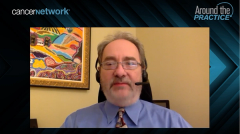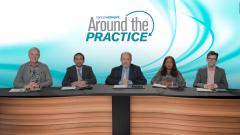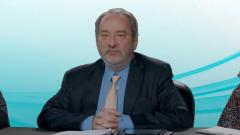
Treatment Selection of Bispecifics in Relapsed-Refractory MM
Focusing their discussion on clinical data in R/R multiple myeloma studies, panelists highlight current and emerging bispecific antibodies for treating patients that have progressed after multiple lines of therapy.
Episodes in this series

Transcript:
Robert Z. Orlowski, MD: At least in the past, there were studies showing that folks who were CD38 refractory with regard to their disease had a poor outcome, but now we’ve got some BCMA-targeted therapies, and the most recent development, Ajay, was within the past month. Teclistamab was approved. Tell us about how that drug works.
Ajay K. Nooka, MD: It’s a great advancement that we had from a bispecific standpoint. These are slightly different than the naked antibodies we’re used to with daratumumab or isatuximab, which are targeting CD38. This bispecific that was just approved, teclistamab, is targeting not only the BCMA, but it also targets CD3, which is present on the T cells and makes the T cell-directed killing of the myeloma cell. It’s very unique technology, very effective. It has been translated into clinical practice, and clearly we’re seeing responses in these refractory patients, unprecedented responses that we’ve never seen before.
Robert Z. Orlowski, MD: Is it CAR [chimeric antigen receptor] T-cell therapy in a bottle, kind of?
Ajay K. Nooka, MD: Yes, that’s a simple way to say it.
Robert Z. Orlowski, MD: Fair enough. Cesar, tell us about what you think the role of teclistamab is in relapsed/refractory myeloma.
Cesar Rodriguez, MD: Teclistamab, at the moment, is FDA approved for people who have had 4 prior lines of therapy and have been exposed to a proteasome inhibitor, an immune modulator, and an anti-CD38 agent. It’s going to be used in people who are heavily pretreated, which is an area that before CAR T therapy and bispecific therapy were available, we were having poor success in having a good response and control of the disease. We were approving drugs that had only 30% response rates, and we were getting excited with a 30% response rate as a single agent. Teclistamab is showing response rates of 63% as a single agent, so that benefits, it’s something we’re all excited about. Everybody wants to start treating patients with this agent, and there’s a long waitlist to try to get patients started on this regimen who are either refractory to the 3 classes or heavily pretreated. Do I think this is the niche where teclistamab is going to stay? I don’t think so. It’s going to probably move up front. But for now, anybody who is shown to be refractory to IMiDS [immunomodulatory drugs], proteasome inhibitors, and anti-CD38, this is an excellent option for them.
Robert Z. Orlowski, MD: Ola, teclistamab isn’t the only BCMA bispecific out there. Tell us about elranatamab, which is one of the others.
C. Ola Landgren, MD: That’s another of these bispecifics that go after the same target we discussed previously, the BCMA, and it also goes after CD3. And it’s one more, but there are more, I don’t know how many, 5 or 6 additional ones beyond elranatamab. So, elranatamab was presented at ASH [American Society of Hematology] this meeting, in the phase 1 trial. This was the MagnetisMM program that Pfizer is leading. The phase 1 MagnetisMM trial has 55 patients, and they showed an overall response rate with the single drug at 64%. That’s fantastic. If you think about all the drugs we have approved, carfilzomib or daratumumab, and all these other drugs we were talking about, they were FDA approved on response rates in the range of 20% to 30%.
Elranatamab has a 64% overall response rate, and 38% of patients were in CR [complete response]. These were patients who were pretty sick. The median number of prior lines of therapy was 5, and there was a range from 2 all the way up to 14 prior lines of therapy when patients were enrolled. So, this is another option. It‘s subcutaneous. Looking at these different drugs, they all go after the same targets, but there are differences in the drugs, the way they are administered, the CRS [cytokine release syndrome] rates are different, the dosing schedules are different. We will see a lot of emerging data in the future regarding these different compounds.
Amrita Krishnan, MD: The nice thing about the elranatamab data, they also showed data, and I can’t remember, I believe it was MagnetisMM-3, with a prior BCMA-treated cohort, because that, for us, is going to be the biggest question in terms of sequencing these agents. Then the other point I did want to make is in terms of infection, and that’s across the board. As these drugs get more widely used, the success is going to be paramount in terms of good supportive care. These patients have profound [hypogammaglobulinemia]. Elranatamab did a nice job of quantifying that, it was about 70% of patients, but also other atypical infections, PJP [pneumocystis jiroveci pneumonia], CMV [cytomegalovirus] reactivation, all those things, to manage.
Robert Z. Orlowski, MD: Maybe you can continue and tell us about the MonumenTAL data, which are with talquetamab, and tell us a bit about that molecule as well.
Amrita Krishnan, MD: If you didn’t think myeloma was complicated before, this is another exciting advance. It’s a somewhat newer target, GPRC5D, it’s expressed in keratinized tissue, so that explains some of the on-target toxicity of these agents. Again, bispecific, given either weekly or biweekly subcutaneously. The response rates, they’re all the same in terms of the bispecifics, the mid-60% range. It had a few unique toxicities in terms of skin, nail toxicity, and dysgeusia in about 50% of patients, so managing those toxicities [is important]. Interestingly, the infection profile was a bit different, grade 3 infections only in 19% of patients. This suggests not all bispecifics are created equal, and again, some of that may help direct choice for our patients, but still the sequencing issue remains unclear.
Robert Z. Orlowski, MD: For those of you at home, dysgeusia is a change in taste, which sometimes can be associated with weight loss, which was seen in some of those patients as well. Cesar, we may soon get talquetamab FDA approved as well, and in that case, do you get teclistamab or talquetamab, or one of the other BCMA bispecifics? How do we choose?
Cesar Rodriguez, MD: Right now it’s simple because we only have one FDA approved, teclistamab. Out of the other BCMAs…we have elranatamab…ABBV-383, we also have REGN5458, so we’re going to have about 5 BCMA-directed bispecifics that are hopefully going to all be approved within the next year or year and a half. They all have similar response rates. They all have CRS. They all need to be given in the hospital. The differences are the degree of CRS, the number of step-up doses you need to give, and how frequently you need to give it, whether it’s weekly, every other week, every 3 weeks, and whether you start spacing it out after a certain time point. Trying to choose between the BCMAs once we’re going to have all these options, that’s going to be patient specific.
Out of the BCMAs, the unique one that’s coming up soon is going to be the ABBV-383, which is given every 3 weeks. There’s no step-up dosing. It only requires a 2-day hospital stay, as opposed to the other ones that require a more prolonged hospital stay. It’s going to be personalized, case by case. Now, between BCMA bispecifics or a GPRC5D like talquetamab, or an FcRH5 like cevostamab, there are other factors we need to keep in mind. One of them, like Amrita said, is infection. The infection signal that we’re seeing with BCMA bispecifics is higher than the other 2 targets, GPRC5D and FcRH5. That’s something to keep in mind. If it’s somebody who’s already immunocompromised or frail and you’re concerned about potential infections, or who has a compromised airway with COPD [chronic obstructive pulmonary disease] or asthma, I might try to favor the other 2 targets. Or if they’ve been previously exposed to a BCMA agent, whether it be CAR T or an antibody-drug conjugate, or another BCMA bispecific, I might try to consider doing a GPRC5D or an FcRH5 therapy.
Robert Z. Orlowski, MD: Just to clarify, the hospitalization is usually only for the step-up dosing and the first full dose. After that, as long as people do well, they can get outpatient therapy for the most part.
Cesar Rodriguez, MD: That is correct. Right now, the hospitalization is just for the step-up doses, because that’s when we’re seeing the majority of CRS. But we also need to keep in mind that when people have a long pause of their treatment and we restart them on treatment, it would be wise to consider rehospitalizing these patients for that dose in case they develop CRS. Until we optimize the management of CRS or prevent it, that’s something that might be better off in a hospital setting.
Amrita Krishnan, MD: The choices, though, I’m going to push back at Cesar. No institution is going to have 5 BCMA-directed bispecifics on their formulary, so some of these decisions may be out of our hands as well. But some of it we could probably direct in terms of some choice. Maybe you get 2, but even that’s probably a lot. More of the issue also to me is the idea, again, people say myeloma is a marathon now. It’s even more important now because there are data presented at this meeting from the [University of Texas] MD Anderson [Cancer Center] group in terms of looking at responses after relapse from ide-cel [idecabtagene vicleucel], for example, and what are you going to respond to as your next T cell-directed therapy. There are data from UCSF [University of California, San Francisco], similarly, so it becomes this question of choosing, do you do CAR T [therapy] now, do you do it later, would you maybe use GPRC targeting first? Those are important questions.
Transcript edited for clarity.
Newsletter
Stay up to date on recent advances in the multidisciplinary approach to cancer.






























































































